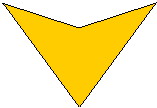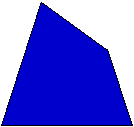Or search by topic
Number and algebra
Geometry and measure
Probability and statistics
Working mathematically
Advanced mathematics
For younger learners
Making Maths: Kites and Darts



Penrose's "kites and darts" tessellation is special because there is no repeating pattern in it. Here you can create templates of the kite and dart shapes below so you can make all manner of tessellations yourself. Here's how:
You will need:
- Pencil
- Sponges (the ones used for washing up would be best)
- Poster paints
- Scissors
- Paper
- Ruler


What to do:
- Carefully copy the templates onto paper, or print them off, and cut out the shapes.
- Draw round the paper template on a sponge (if you've got sponges with a scouring i.e. rough surface then use this side to draw onto).
- Carefully cut out your two sponge shapes, making sure that you stay very closely to the outline otherwise they may not fit together.
- Dip the sponge into the paint and press it firmly onto the paper to make a print. You'll need to use a different sponge for each colour you choose.
- Have a go at making the Penrose "kites and darts", or try to create a tessellation using shapes of your choice. Don't forget to draw them accurately otherwise they may not fit together. You'll probably have to draw your design on paper first.
Why not have fun with your own template for Christmas or New Year?
Can you design a star that tessellates with another shape?
You could even use your pattern to make wrapping paper for birthdays too.
You may also like
Penta Place
Penta people, the Pentominoes, always build their houses from five square rooms. I wonder how many different Penta homes you can create?
Tessellating Triangles
Can you make these equilateral triangles fit together to cover the paper without any gaps between them? Can you tessellate isosceles triangles?

